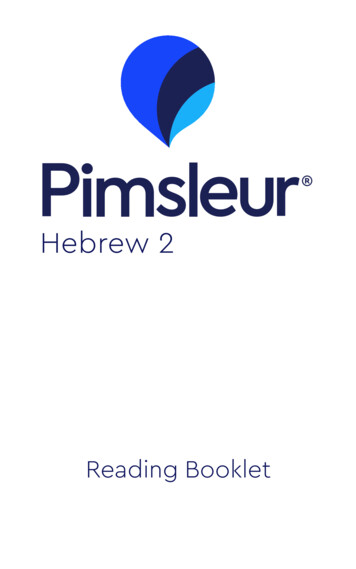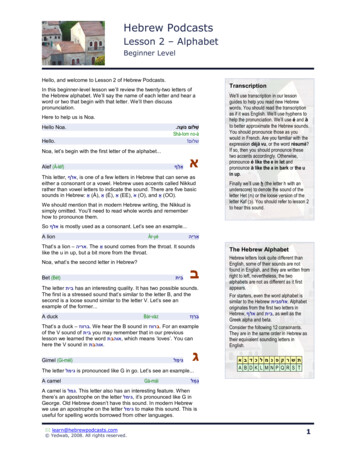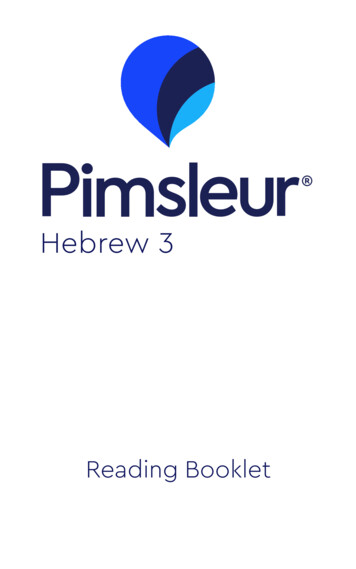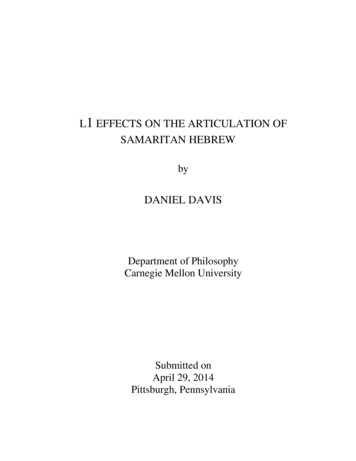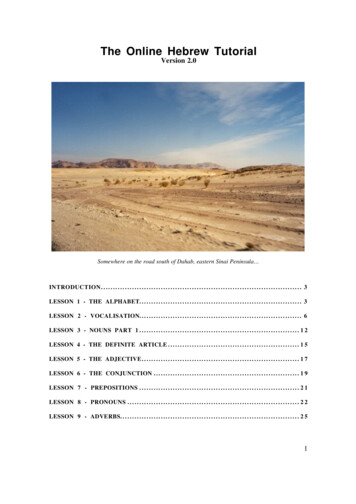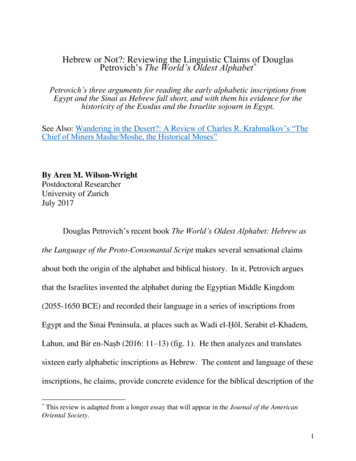
Transcription
Hebrew or Not?: Reviewing the Linguistic Claims of DouglasPetrovich’s The World’s Oldest Alphabet*Petrovich’s three arguments for reading the early alphabetic inscriptions fromEgypt and the Sinai as Hebrew fall short, and with them his evidence for thehistoricity of the Exodus and the Israelite sojourn in Egypt.See Also: Wandering in the Desert?: A Review of Charles R. Krahmalkov’s “TheChief of Miners Mashe/Moshe, the Historical Moses”By Aren M. Wilson-WrightPostdoctoral ResearcherUniversity of ZurichJuly 2017Douglas Petrovich’s recent book The World’s Oldest Alphabet: Hebrew asthe Language of the Proto-Consonantal Script makes several sensational claimsabout both the origin of the alphabet and biblical history. In it, Petrovich arguesthat the Israelites invented the alphabet during the Egyptian Middle Kingdom(2055-1650 BCE) and recorded their language in a series of inscriptions fromEgypt and the Sinai Peninsula, at places such as Wadi el-Ḥôl, Serabit el-Khadem,Lahun, and Bir en-Naṣb (2016: 11–13) (fig. 1). He then analyzes and translatessixteen early alphabetic inscriptions as Hebrew. The content and language of theseinscriptions, he claims, provide concrete evidence for the biblical description of the*This review is adapted from a longer essay that will appear in the Journal of the AmericanOriental Society.1
Exodus and the Israelite sojourn in Egypt (2016: 195–199). At root, however,Petrovich’s historical arguments rely on his claim that the early alphabeticinscriptions record the Hebrew language. This claim proves unsustainable in lightof linguistic evidence.Figure 1: A Map of Egypt Showing the Distribution of the Early AlphabeticInscriptions2
The premise of Petrovich’s linguistic argument is that one must first identifythe language of a text before being able to decipher it.1 Accordingly, Petrovich(2016: 191) offers three pieces of evidence for identifying the language of the earlyalphabetic inscriptions as Hebrew: 1) the word “Hebrews” (Egyptian ỉbr) appearson the Egyptian stele Sinai 115 from the Egyptian turquoise mining facility atSerabit el-Khadem, in the Sinai Peninsula; 2) Hebrew names can be found for allof the original alphabetic letters; 3) the early alphabetic inscriptions contain thepersonal names Moses, Asenath, and Ahisamach, which are only found in theHebrew bible. Unfortunately, none of this of evidence holds up under scrutiny.Petrovich’s reading of “Hebrew” (ỉbr) in Sinai 115 runs into epigraphic andlinguistic difficulties. Epigraphically, it relies on an unlikely interpretation of theeighth sign on the stele. This sign consists of a rough square in outline form (fig.2), which resembles both a hieroglyphic p (fig. 3) and early alphabetic b (fig. 4).Similar looking p’s appear on contemporary Egyptian inscriptions from Serabit elKhadem (e.g., Sinai 516; fig. 5) and, since the remainder of Sinai 115 is written inEgyptian, the eighth pictograph most likely represents a hieroglyphic p. Petrovich(2016: 18–19), however, opts for an alphabetic reading because the eighth sign1This is not necessarily the case. As E. J. W. Barber (1974: 6–12) points out, Old Persian,Akkadian, Elamite, Sumerian, Hittite, and Ugaritic were all unknown languages prior todecipherment. Seen in this light, Petrovich’s insistence that the early alphabetic inscriptionsmust record a known Semitic language, as opposed to a previously undiscovered one, seemsstrange.3
differs from more common renderings of the hieroglyphic p, which are executed inbas relief. Yet the outlined form is a valid variant of the p hieroglyph, whichoccurs in other Egyptian inscriptions, and cannot be dismissed as an anomaly.Also problematic is Petrovich’s reading of a hieroglyphic r following pictographeight (2016: 19). The available photographs feature a roughly oval shapefollowing the eighth pictograph, but it is unclear whether this shape is ahieroglyphic character or damage to the surface of the stele. Petrovich does notacknowledge the second possibility or offer argue in favor of reading a hieroglyphhere.Figure 2: The Eighth Pictograph from Sinai 115 (Courtesy of the EgyptExploration Society)4
Figure 3: A Hieroglyphic p from Sinai 115 (Courtesy of the Egypt ExplorationSociety)Figure 4: An Alphabetic b from Sinai 351 (Image by A. M. Wilson-Wright)5
Figure 5: A Hieroglyphic p from Sinai 516 (Courtesy of the Semitic Museum,Harvard University)Even if we accept Petrovich’s reading of eighth pictograph, it is unlikely thatỉbr represents the word “Hebrew.” In Biblical Hebrew, the word for Hebrew,ˤibrî, is written with an initial ˤ (a notoriously difficult-to-pronounce sound called avoiced velar fricative; it is produced by constricting the muscles at the back of thethroat). Although this sound is also found in Egyptian, the word that Petrovichclaims means “Hebrew” begins with a glottal stop (the sound found in the middleof the exclamation “uh-oh!”). To explain this mismatch, Petrovich (2016: 24)proposes two possible scenarios: as the first recorded instance of the word Hebrew,ỉbr was not subject to the later conventions of spoken and written Hebrew; or thepronunciation of Hebrew ˤ was closer to that of Egyptian ỉ than Egyptian ˤ. Thefirst is an argument from exceptionalism and cannot be sustained. The second6
argument falters on linguistic evidence. In Middle Kingdom writings of Semiticpersonal names, Semitic ˤ is always represented by Egyptian ˤ, never by ỉ, whichshows that Semitic ˤ was closer in pronunciation to Egyptian ˤ than ỉ (Hoch 1994:492–497; Schneider, 1992: 116–174). Conversely, Egyptian ˤ always correspondsto Hebrew ˤ in Egyptian loanwords into Hebrew (Muchiki, 1999: 264). For thesereasons, ỉbr most likely does not represent the word “Hebrew.”Even if we accept Petrovich’s reading and translation of Sinai 115, theappearance of the word “Hebrew” in a Middle Kingdom Egyptian inscription fromSerabit el-Khadem does not guarantee that the alphabetic inscriptions from Wadiel-Ḥôl, Lahun, Bir en-Naṣb, and New Kingdom (1550–1069 BCE) Serabit elKhadem were written in the Hebrew language. In fact, it is unclear whether theearly alphabetic inscriptions even record the same Semitic language and Petrovichdoes not offer any evidence that they did. At most, Petrovich’s reading—bracketing for a moment its epigraphic and linguistic drawbacks—shows thatindividuals identified as Hebrews may have been present at Serabit el-Khademduring the Middle Kingdom (2055-1650 BCE) and the Egyptians wrote about themin a single stele.The appeal to letter names also proves problematic. In the second appendixto the book, Petrovich (2016: 205–206, 209–211, 217, 220–222, 224) discounts tentraditional letter names (gîmel, hê, zayin, ḥêt, ṭêt, sāmek, ṣādê, qôp, šîn, and tāw)7
because they do not appear in Biblical Hebrew. As a motivation for this practice,he writes, “If one grants that the original alphabet could have been Hebrew, thequestion arises as to the original names of each Hebrew letter, given that thealphabet is based on an acrophonic system2 and that there is a long and wellestablished tradition of fixed Hebrew words that correspond to each letter of thealphabet” (2016: 201). In other words, Petrovich’s proposed names rely on theassumption that the inventors of the alphabet spoke Hebrew, and thus his appeal toletter names turns into a circular argument. At best, this argument serves aspotential confirmation that Petrovich’s hypothesis is correct. If he could not findHebrew names for the letters of the alphabet, it would be unlikely that theinventors of the alphabet spoke Hebrew. It does not show a priori that earlyalphabetic inscriptions record the Hebrew language.Petrovich’s final argument for seeing Hebrew as the language of the earlyalphabetic inscriptions relies on personal names, but this argument suffers fromthree problems. First, personal names are poor markers of linguistic affiliationbecause they often come from different languages. Egyptian names, like Phineasand Passhur, appear in the Hebrew Bible (Exod 6:25; Jer 20:1), yet no one would2The acrophonic principle refers to the link between sound and pictograph found in somewriting systems. In an acrophonic alphabet, the phonetic value of each letter comes from theobject it represents. If English were written in an acrophonic alphabetic, a house pictograph, forexample, could represent h-sound because ‘house’ begins with ‘h’. In a Semitic language, bycontrast, where the word for house is bayt, a house pictograph represents the b-sound.8
claim that the Bible is written in Egyptian. Or, to cite a more contemporaryexample, my first name comes from Norwegian—it is a dialectal spelling of Arne,itself from Old Norse Arni ‘eagle’—but I publish exclusively in American English.Second, two of the personal names that Petrovich flags as being exclusivelyHebrew–Moses ( mśy ‘born of DN’) and Asenath (ns-n(y)t ‘Belonging toNeith’)—most likely come from Egyptian and so it would be unsurprising to findthem in an Egyptian context such as Bir en-Naṣb or Serabit el-Khadem (Muchiki1999: 208–209; Van Seters, 1987: 115–116). Third, Petrovich’s appeal to personalnames forms a circular argument: he only found these names by reading the earlyalphabetic inscriptions as Hebrew; yet he cites them as evidence that the earlyalphabetic inscriptions were written in Hebrew.Petrovich’s three arguments for reading the early alphabetic inscriptionsfrom Egypt and the Sinai as Hebrew fall short, and with them his evidence for thehistoricity of the Exodus and the Israelite sojourn in Egypt. But could we come upwith better arguments for reading the early alphabetic inscriptions as a Hebrew andsalvage Petrovich’s historical claims? This seems unlikely due to the gulf ofcenturies separating the earliest Hebrew texts from the early alphabeticinscriptions. The earliest possible witnesses to the Hebrew language date to the 9thcentury BCE (Rollston 2012: 68), while the earliest alphabetic inscriptions date tothe reign of Pharaoh Amenemhat III (1831-1786 BCE). A thousand or more years9
is a long time in linguistic history and allows for plenty of time for languages tochange dramatically. In the history of English, for example, a similar span of timeseparates contemporary English from Anglo-Saxon (Old English), which differsconsiderably from modern English and would not be intelligible to an Englishspeaker today. Compare, for example, the opening lines of the Lord’s Prayer incontemporary English (NRSV translation) and Anglo-Saxon:Our father in heaven,hallowed be your name.Fæder ūre, ðū ðē eart on heofonum,Sī ðīn nama gehālgodPresumably, Hebrew’s 2nd millennium BCE linguistic ancestors would differ atleast as much from Iron Age Hebrew as contemporary English differs from AngloSaxon. Thus, even if the early alphabetic inscriptions did record a linguisticancestor of Hebrew, it would likely be so different from Hebrew that we wouldconsider it a separate language.Ultimately, Petrovich’s three pieces of evidence for reading the earlyalphabetic inscriptions as Hebrew are fatally flawed: the word “Hebrew” does notappear in the Egyptian inscription Sinai 115 from Serabit el-Khadem, and even if itdid, its presence does not demonstrate the early alphabetic inscriptions from otherlocations were written in Hebrew; the ability to find Hebrew names for the lettersof the alphabet relies on the assumption that the Israelites invented the alphabet;10
and personal names fail as an indicator of linguistic identity because they oftencome from other languages. In addition, it is unclear that Hebrew existed as adistinct language during the Middle Kingdom, when many of the early alphabeticinscriptions were written. In light of these many problems, Petrovich’s bookcannot provide reliable proof for the historicity of the Exodus and the sojourn inEgypt.ReferencesBarber, E. J. W. Archaeological Decipherment: A Handbook. Princeton:Princeton University Press, 1974.Hoch, James E. Semitic Words in Egyptian Texts of the New Kingdom and ThirdIntermediate Period. Princeton: Princeton University Press, 1994.Muchiki, Yoshiyuki. Egyptian Proper Names and Loanwords in North-WestSemitic. SBLDS 173. Atlanta: SBL, 1999.Petrovich, Douglas. The World’s Oldest Alphabet: Hebrew as the Language of theProto-Consonantal Script. Jerusalem: Carta, 2016.11
Rollston, Christopher A. “What’s the Oldest Hebrew Inscription?” BAR 38.3(2012): 32–40, 66–68.Schneider, Thomas. Asiatische Personennamen in ägyptischen Quellen des NeuenReiches. OBO 114. Göttingen: Vandenhoeck & Ruprecht, 1992.Van Seters, John. “Moses.” In Encyclopedia of Religion, edited by Mircea Eliade,vol. 10, 115–121. New York: Macmillan, 1987.12
of the original alphabetic letters; 3) the early alphabetic inscriptions contain the personal names Moses, Asenath, and Ahisamach, which are only found in the Hebrew bible. Unfortunately, none of this of evidence holds up under scrutiny. Petrovich’s reading of “Hebrew” (ỉbr) in Si


